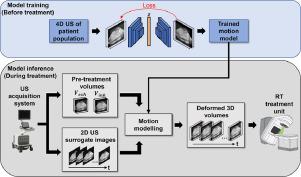Medical Image Analysis ( IF 10.7 ) Pub Date : 2021-10-09 , DOI: 10.1016/j.media.2021.102260 Tal Mezheritsky 1 , Liset Vázquez Romaguera 1 , William Le 2 , Samuel Kadoury 3

|
Radiotherapy is a widely used treatment modality for various types of cancers. A challenge for precise delivery of radiation to the treatment site is the management of internal motion caused by the patient’s breathing, especially around abdominal organs such as the liver. Current image-guided radiation therapy (IGRT) solutions rely on ionising imaging modalities such as X-ray or CBCT, which do not allow real-time target tracking. Ultrasound imaging (US) on the other hand is relatively inexpensive, portable and non-ionising. Although 2D US can be acquired at a sufficient temporal frequency, it doesn’t allow for target tracking in multiple planes, while 3D US acquisitions are not adapted for real-time. In this work, a novel deep learning-based motion modelling framework is presented for ultrasound IGRT. Our solution includes an image similarity-based rigid alignment module combined with a deep deformable motion model. Leveraging the representational capabilities of convolutional autoencoders, our deformable motion model associates complex 3D deformations with 2D surrogate US images through a common learned low dimensional representation. The model is trained on a variety of deformations and anatomies which enables it to generate the 3D motion experienced by the liver of a previously unseen subject. During inference, our framework only requires two pre-treatment 3D volumes of the liver at extreme breathing phases and a live 2D surrogate image representing the current state of the organ. In this study, the presented model is evaluated on a 3D+t US data set of 20 volunteers based on image similarity as well as anatomical target tracking performance. We report results that surpass comparable methodologies in both metric categories with a mean tracking error of 3.52.4 mm, demonstrating the potential of this technique for IGRT.
中文翻译:

卷积自动编码器基于人群的 3D 呼吸运动建模,用于 2D 超声引导放射治疗
放射治疗是一种广泛用于各种癌症的治疗方式。将放射线精确输送到治疗部位的一个挑战是管理由患者呼吸引起的内部运动,尤其是在肝脏等腹部器官周围。当前的图像引导放射治疗 (IGRT) 解决方案依赖于电离成像模式,例如 X 射线或 CBCT,它们不允许实时目标跟踪。另一方面,超声成像 (US) 相对便宜、便携且非电离。虽然 2D US 可以以足够的时间频率采集,但它不允许在多个平面上进行目标跟踪,而 3D US 采集不适合实时。在这项工作中,为超声 IGRT 提出了一种新颖的基于深度学习的运动建模框架。我们的解决方案包括一个基于图像相似性的刚性对齐模块与一个深度可变形运动模型相结合。利用卷积自动编码器的表示能力,我们的可变形运动模型通过常见的学习低维表示将复杂的 3D 变形与 2D 替代 US 图像相关联。该模型接受了各种变形和解剖结构的训练,使其能够生成以前未见过的受试者的肝脏所经历的 3D 运动。在推理过程中,我们的框架只需要两个处于极端呼吸阶段的肝脏预处理 3D 体积和一个代表器官当前状态的实时 2D 替代图像。在这项研究中,基于图像相似性以及解剖目标跟踪性能,在 20 名志愿者的 3D+t US 数据集上评估了所提出的模型。2.4 毫米,展示了这种技术在 IGRT 中的潜力。











































 京公网安备 11010802027423号
京公网安备 11010802027423号